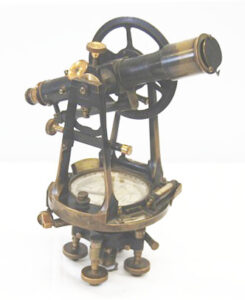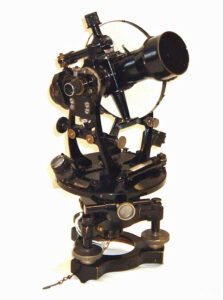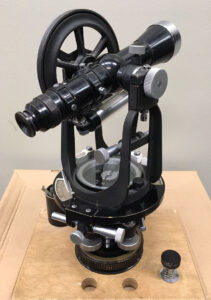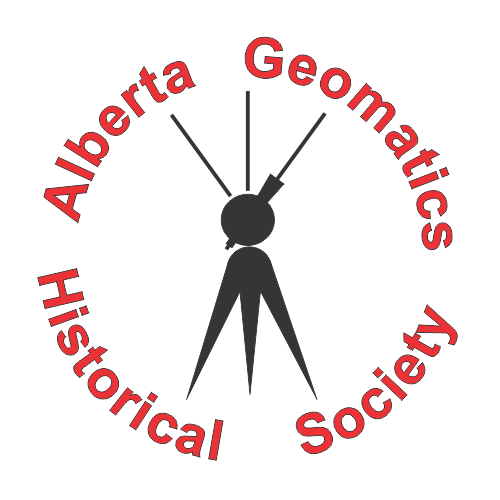
09. Is it a Theodolite or Transit? Early Open Vernier Theodolites and Transits
By Gordon Olsson
What is the difference between a theodolite and transit? The term “theodolite” can be traced back to the sixteenth century in Europe. Although there were several variations of it, basically it was an instrument that could measure vertical and horizontal angles. During the first half of the nineteenth century, the term “transit” was popularized in America. The transit was fundamentally a theodolite in which its telescope could be completely rotated 360 degrees in a vertical plane around the horizontal axis. This enabled back-sighting and fore-sighting on opposite sides of the vertical circle and doubling of angles resulting in more accurate line production and measurement of angles.
So, what about the term “transit theodolite” which was used in several early DLS manuals as being acceptable for township survey work? With the popularity of the American transit, instrument makers in England and other European countries started to produce theodolites in which the telescope could be rotated 360 degrees just like the American transit. These they called “transit theodolites.” In later versions of the manual, the term “transit theodolite” was dropped as eventually telescopes in most theodolites used by surveyors could be rotated 360 degrees around the horizontal axis.
Over the years, other common interpretations of the terms theodolite and transit have emerged. For example, “a theodolite is more accurate than a transit” or “theodolites have enclosed circles that are read optically, and transits have open faced circles that are read by verniers.” While these meanings are not historically correct, meanings of words do evolve.
In describing the various theodolites and transits in the collection, the term used by the manufacturer of the instrument is used if it can be found on the instrument, on its container or in the manufacturer’s manuals or catalogues. Normally, instruments manufactured in Europe are referred to as theodolites while those manufactured in the USA are referred to as transits.

T. Cooke and Sons Ltd. Theodolite. It predates 1913 based on the labels on the theodolite box. It is purported to have been used by A.G. Stewart ALS#078. T. Cooke & Sons was founded in York, England in 1837. In 1922 it was amalgamated with the firm of Troughton & Simms of London. Donated by C.H. Weir ALS
ALSA 2007.27.06
Cooke, Troughton & Simms Theodolite. This theodolite was made after 1922. T. Cooke & Sons amalgamated with Troughton & Simms of London in 1922. The new firm became Cooke, Troughton & Simms. The source of this theodolite is unknown.
ALSA 2006.20.01
Comes with tripod ALSA 2006.20.02

Keuffel & Esser Transit. Inscribed on the compass of the transit is “Keuffel & Esser Co. Made in USA.” K&E, as the firm was known, offered surveying instruments starting in 1876. In 1982, it filed for bankruptcy.
Donated by Bob Peverelle
ALSA 2012.05.03
Comes with tripod ALSA 2012.05.04
Path Instruments Transit. Path transits were made in Japan and sold by the Hughes Owens Co. in the 1950s. This transit is on display at the Leduc Discovery Centre.
Donated by Doug Kelsch, UMA Engineering
ALSA 2007.30.01

Astra Transit. Astra Transits were made in Japan.
Donated by Lou Breton ALS
ALSA 2008.15.02
Sources of Information:
- Davistown Museum, Buff & Buff Manufacturing Company. Article: The Transit an American Instrument, by Milton Estabrook: http://www.davistownmuseum.org/bioBuff.html
- Google Groups, sci.engr.surveying, Transit – vs – Theodolite, See Michael G. Shackelford, PLS. Nov 9, 1999: https://groups.google.com/g/sci.engr.surveying/c/8SU1Z1BMPnA?pli=1.
- Virtual Museum of Surveying website: The Surveyor’s Basic Tools, The Transit and the Theodolite: http://www.surveyhistory.org/the_surveyor’s_basic_tools.htm
Author: Gordon Olsson, ALS (Hon. Life)
December 5, 2021
Copyright 2024 © Alberta Geomatics Historical Society
